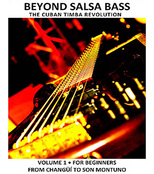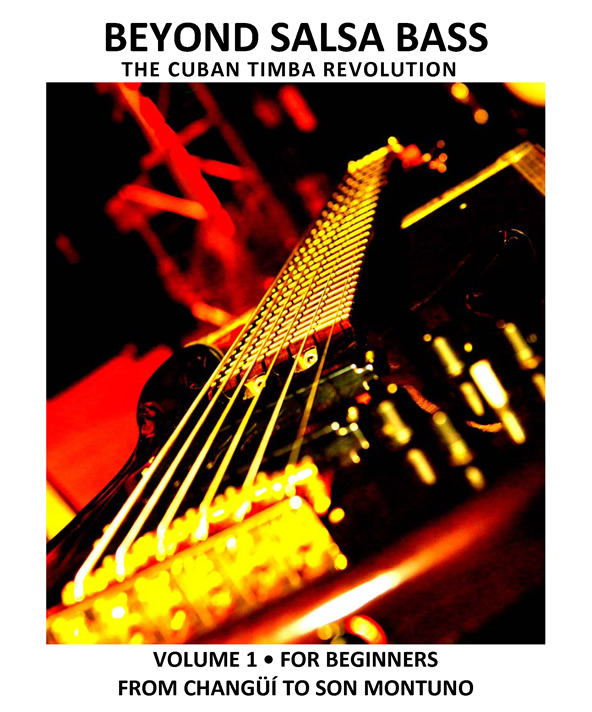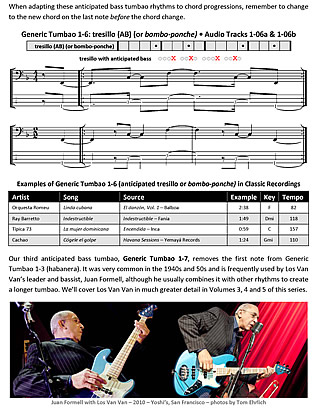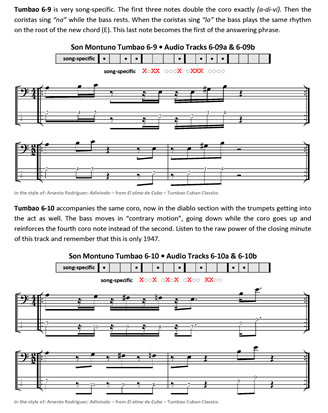|
TOTAL:
|
$0.00 |

|

|
|
Your On-Line Source for Latin Music Downloads!
|

Contact us to license Latin music for tv & film.
|

Beyond Salsa Bass Vol1Artist: Kevin Moore
|
||

| # | Name | Play | Time | Info |
|---|---|---|---|---|
| 01 | Anticipated tresillo - fast |
|
0:53 | Track 18 of 212 - Beyond Salsa Bass Volume 1 |
| 02 | Son montuno tumbao 9 - fast |
|
1:11 | Track 143 of 212 - Beyond Salsa Bass Volume 1 |
| 03 | Son montuno 27 - fast |
|
0:56 | Track 123 of 212 - Beyond Salsa Bass Volume 1 |
| 04 | Piano changuí 1a - fast |
|
1:06 | Track 187 of 212 - Beyond Salsa Bass Volume 1 |
| Play All - Oir Todas |  |
|||

| Name | Difficulty | Notation | Price | ||
|---|---|---|---|---|---|
| eBook Beyond Salsa Bass Vol 1 | Sample | Easy | Bass - Bajo | $14.99 |

|

Special notes about Beyond Salsa Bass Volume 1:
** Beyond Salsa Bass Volume 1 is the first in a series of instructional methods composed of an eBook with audio tracks. The eBook, audio tracks, and video clips are sold separately.
The eBook is a personalized pdf download compatible with Adobe Acrobat (more eBook info here).
** Audio: The Audio product includes a fast and slow file for each bass tumbao in the book as well as various example files corresponding to the text. Note that for every piano tumbao in our sister volume, Beyond Salsa Piano Vol.1, there is a corresponding bass tumbao in the Beyond Salsa Bass Vol.1 book and audio product. In these cases, the piano audio is included in one channel. In other cases, the audio consists of just bass and clave. If this seems confusing, think of it this way: Beyond Salsa Piano Vol.1 is a subset of Beyond Salsa Bass Vol.1. The bass book has a bass tumbao for every piano tumbao in the piano book, but the bass book also has many more additional tumbaos for tracks not covered in the piano volume. The audio tracks and eBook for Beyond Salsa Bass Volume 1 can be purchased on this page.
** Beyond Salsa Bass follows the same game plan as Beyond Salsa Piano: five volumes covering the history of Cuban bass playing - from changüí and son to songo and timba - followed by a series of books on individual star bass players.
INTRODUCTION TO BEYOND SALSA BASS -- The primary job of the bassist in Latin popular music is to play a repeating figure that establishes
both a chord progression and a rhythmic groove. We call these figures tumbaos. A tumbao is
repeated – sometimes with variations – for a fixed or open‐ended period of time, after which a
transition leads to another such tumbao, and so on.
Bass tumbaos are used sparingly (if at all) during the opening section of an arrangement (aka, the
cuerpo, or canto) in which the lead vocalist sings a popular song, itself divided into subsections of
four to eight claves in length. The bass tumbaos come in during the second major section, (the
montuno section), comprised of call and response vocals (coros), instrumental solos played over a
repeated bass tumbao, and, beginning in the 1940s, sections featuring instrumental riffs (mambos).
In the earliest years of son and danzón there was no montuno section at all, but over time, the
montuno section has grown longer and longer. Today, the cuerpo comprises only a small percentage
of the overall length of an arrangement, especially in concert.
 If you’re a professional bassist in another genre seeking to get up to speed on Latin music, you’ll
have no problem working through this book as it’s written – in chronological order. If you’re a true
beginner, on the other hand, you’ll find that the difficulty level varies. The first chapter is very easy, as are Chapter 4 on jazzband (aka, big band) bass tumbaos and Chapter 5 on son. Some of the
danzón and son montuno tumbaos are just as easy, but others are quite challenging, so feel free to
skip around. If you hit a tumbao that’s too hard for you, don’t assume that the rest of the book will
be equally difficult. There are extremely easy tumbaos in every section, even in the later volumes.
My advice is always to start with the “lowest‐hanging fruit”.
If you’re a professional bassist in another genre seeking to get up to speed on Latin music, you’ll
have no problem working through this book as it’s written – in chronological order. If you’re a true
beginner, on the other hand, you’ll find that the difficulty level varies. The first chapter is very easy, as are Chapter 4 on jazzband (aka, big band) bass tumbaos and Chapter 5 on son. Some of the
danzón and son montuno tumbaos are just as easy, but others are quite challenging, so feel free to
skip around. If you hit a tumbao that’s too hard for you, don’t assume that the rest of the book will
be equally difficult. There are extremely easy tumbaos in every section, even in the later volumes.
My advice is always to start with the “lowest‐hanging fruit”.
This volume’s introductory technical chapter categorizes the simplest and most common bass
tumbaos of Latin music: those that repeat their rhythm after only two main beats.
The use of familiar names for these tumbaos (bolero, habanera, guaracha, tresillo, bombo‐ponche,
etc.) is strictly optional. Some are common, some are rare, and some are coined for this book.1 I love
using names because it helps me to remember the patterns and gives them personalities that help
me to “get on a first name basis” with them. If this idea doesn't appeal to you, or to your teacher,
just ignore the names and use the numbers instead.
Remember that terminology of all types is
unimportant except as a way to communicate with others – and it’s always easier to learn someone
else’s system of terminology (about which he or she may feel very strongly!) than it is to get the
other person to use your system. The silver lining is that the more ways you think about these patterns – and the more names you learn for them – the more you’ll internalize them, so if a new
teacher or band member introduces you to a new set of terms, learn them enthusiastically. You’ll
then have one more set of “handles” to solidify them in your memory. For example, the ubiquitous
pattern we call anticipated tresillo is also alternately called “king‐kong”, “bombo‐ponche”, “the ‘and’
of 2 and 4” “the ‘a’ of 1 and the ‘and’ of 2”, “tumbao”, and various other names. Learn them all, and
use the one that works best in each situation. Above all, learn to play the pattern and recognize it
when you hear it.
Many master musicians never think or talk about any of this, but they all have an
infallible feeling for which pattern goes where. The idea is to internalize that infallible feeling for
yourself by whatever means works best for your personal learning style.
To learn more about the BEYOND SALSA Series of musical instruction books, the leading source of Afro-Cuban music studies on the planet, please visit http://beyondsalsa.info.
Click here for a pdf sample of the Beyond Salsa Bass Volume 1 eBook.

|

|
Click here for more Beyond Salsa Bass samples. Email the author = kevin [at] timba [dot] com
Beyond Salsa Piano Vol12 Beyond Salsa Piano Vol11 Beyond Salsa Piano Vol10
Beyond Salsa Piano Vol9 Beyond Salsa Piano Vol8 Beyond Salsa Piano Vol7
Beyond Salsa Piano Vol6 Beyond Salsa Piano Vol5 Beyond Salsa Piano Vol4
Beyond Salsa Piano Vol3 Beyond Salsa Piano Vol2 Beyond Salsa Piano Vol1